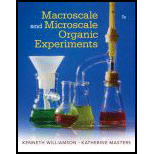
Interpretation:
The statement '' water not used to extinguish most fires in an organic laboratory" should be explained. Also, the safety issues with the given scenario should be explained.
Concept introduction:
The interaction of water and organic compounds makes them unusable as a fire control measure in an organic laboratory. Organic compounds are generally lighter than water and thus float on water. When water is used as a control measure to put out fire the fire is spread due to the flow of water.
An organic laboratory is guided to follow a set of precautious measures which helps in reducing the risks of accident breakout. These measures include use proper disposal and aeration of labs.
Trending nowThis is a popular solution!

Chapter 2 Solutions
Macroscale and Microscale Organic Experiments
- Tires whose sidewalls are made of natural rubber tend to crack and weather rapidly in areas around cities where high levels of ozone and other industrial pollutants are found. Explain.arrow_forward. These resins are organic polymeric networks that contain functional groups that are permanently attached to the resin. One such functional group is sulfonic acid, -SO3H. When placed in water, the resin (being a large organic molecule) will not dissolve. However, the ionic functional groups become hydrated and the resin will swell as it takes up waters of hydration. The resin may then be thought of as a solid solution mixture with the functional groups being "dissolved" but the polymer remaining as a solid. The hydronium ion (H3O+) associated with acidic functional groups like sulfonic acid will dissociate just as it would if the acid were free of the resin. If other cations such as Cu2+ or Na+ are added to the resin, an ion-exchange reaction can occur: . Note that one H+ is released for each positive charge bound to the resin. Since the resin exchanges a hydrogen ion for a sodium ion in this reaction, sulfonic acid resins are called cation-exchange resins. Equilibrium constants may…arrow_forwardWhile cleaning, you accidentally add water to a flask with non-halogenated solvent. Where should you dispose of this mixture? A. Non-halogenated organic waste B. Basic aqueous waste C. Down the sink D. Acidic aqueous wastearrow_forward
- What is the practical importance of distillation in relation to pharmaceutical and medicinal organic chemistry?arrow_forwardYour roommate, a chemistry major, claims to have synthesized the compound CH5 in the lab. Why is that not possible?arrow_forwardTRUE OR FALSE A student synthesizing an organic compound from 2 starting materials. it is determined that starting material X is in excess while starting material Y is the limiting reagent. It is imperative that the measurements of Y are precise in order to determine the correct number of significant figures in the calculation of the theoretical yield Distillation is used in organic chemistry to both purify a compound and determine its approximate boiling point.arrow_forward
- How can we predict if 1- propanol is mixed with distilled water? Are the mass and volume conserved? When you mix two gases what can we predict about the conservation of volume in this case?arrow_forwardIn a small laboratory, the following organic synthesis was under performance. However, the sample had caught fire and ignited. What type of extinguishing method should be taken? If a fire extinguisher is used what type of it should be used? Explain the reasoning behind your choicesarrow_forwardList below three characteristics that a good solvent must satisfy to recrystallize an organic compound that exists in a solid state at room temperature, example: benzoic acid.arrow_forward
- Chemistry 1. Distinguish natural from synthetic polymers in terms of properties. 2. Describe the formation and structure of polymersarrow_forwardWhy do impure chemicals have lowering melting points? Can recrystallization be used to purify all organic compounds?arrow_forwardWhat is the relationship between strength of intermolecular forces and the rate of evaporation between water, methylated spirit and cooking oilarrow_forward
 Macroscale and Microscale Organic ExperimentsChemistryISBN:9781305577190Author:Kenneth L. Williamson, Katherine M. MastersPublisher:Brooks Cole
Macroscale and Microscale Organic ExperimentsChemistryISBN:9781305577190Author:Kenneth L. Williamson, Katherine M. MastersPublisher:Brooks Cole Introduction to General, Organic and BiochemistryChemistryISBN:9781285869759Author:Frederick A. Bettelheim, William H. Brown, Mary K. Campbell, Shawn O. Farrell, Omar TorresPublisher:Cengage Learning
Introduction to General, Organic and BiochemistryChemistryISBN:9781285869759Author:Frederick A. Bettelheim, William H. Brown, Mary K. Campbell, Shawn O. Farrell, Omar TorresPublisher:Cengage Learning Chemistry: The Molecular ScienceChemistryISBN:9781285199047Author:John W. Moore, Conrad L. StanitskiPublisher:Cengage Learning
Chemistry: The Molecular ScienceChemistryISBN:9781285199047Author:John W. Moore, Conrad L. StanitskiPublisher:Cengage Learning Organic ChemistryChemistryISBN:9781305580350Author:William H. Brown, Brent L. Iverson, Eric Anslyn, Christopher S. FootePublisher:Cengage Learning
Organic ChemistryChemistryISBN:9781305580350Author:William H. Brown, Brent L. Iverson, Eric Anslyn, Christopher S. FootePublisher:Cengage Learning
 Introductory Chemistry: A FoundationChemistryISBN:9781337399425Author:Steven S. Zumdahl, Donald J. DeCostePublisher:Cengage Learning
Introductory Chemistry: A FoundationChemistryISBN:9781337399425Author:Steven S. Zumdahl, Donald J. DeCostePublisher:Cengage Learning





